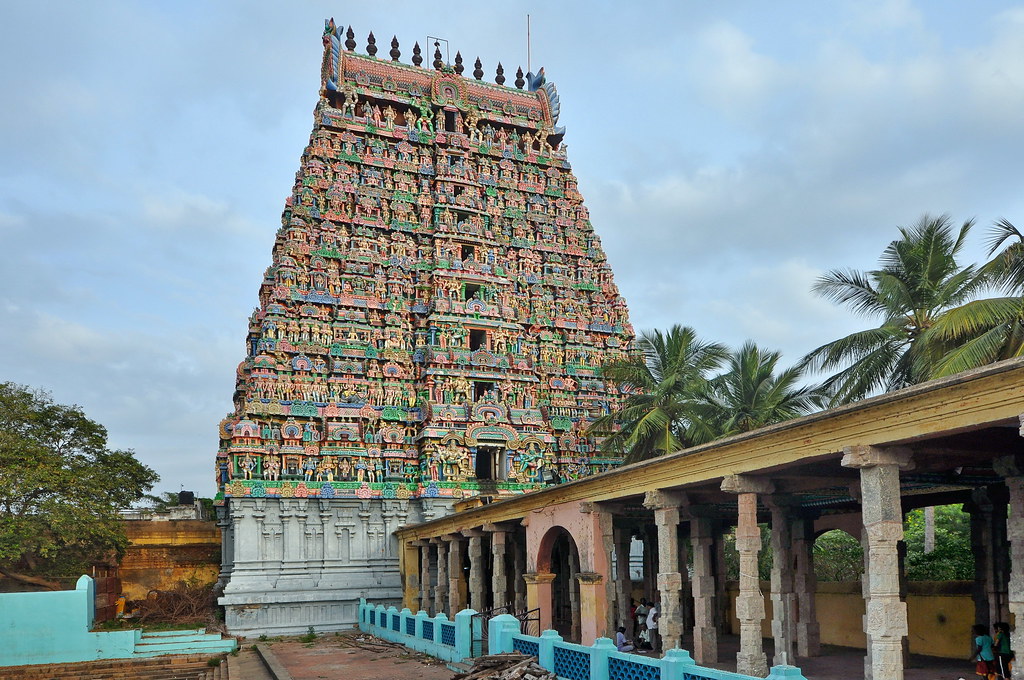Adi Kumbeswarar Temple is a Hindu temple dedicated to the deity Shiva, located in the town of Kumbakonam in Tamil Nadu, India. Shiva is worshipped as Adi Kumbeswarar and is represented by the lingam. His consort Parvati is depicted as Mangalambigai Amman. The presiding deity is revered in the 7th century Tamil Saiva canonical work, the Tevaram, written by Tamil saint poets known as the Nayanmars and classified as Paadal Petra Sthalam.
Shrine’s History
The temple is in existence from Chola times of the 7th century and has been widely expanded by Nayaks during the 15-17th century
Legends Associated with This Shrine
It is believed that the name of the town Kumbakonam is derived from the legend associated with Kumbeswarar Temple. “Kumbakonam”, roughly translated into English as the “Jug’s Corner”, is believed to be an allusion to the mythical pot of the Hindu god Brahma that contained the seed of all living beings on earth. The kumbha is believed to have been displaced by a pralaya effected by Hindu god Shiva’s arrow and ultimately came to rest at the spot where the town of Kumbakonam now stands. The nectar is believed to have fallen in two places – the Mahamaham tank and the Potramarai tank.This event is now commemorated in the Mahamaham festival held every 12 years. Kumbakonam was also formerly known by the Tamil name of Kudamukku.Kumbakonam is also identified with the Sangam age settlement of Kudavayil.
Architectural Relevance of This Shrine
Kumbeswarar temple complex covers an area of 30,181 sq ft and houses four gateway towers known as gopurams.The tallest is the eastern tower, with 11 stories and a height of 128 feet The temple is approached by a corridor 330 ft long and 15 ft wide. There are five silver-plated chariots in the temple used to carry the temple deities during festive occasions. The temple is the largest Shiva temple of Kumbakonam and has a 9-storeyed rajagopuram gateway tower 125 ft tall It is spread over 4 acres in the centre of the town. The temple has 3 concentric compounds, elongated along an east-west axis has triple set of gopurams. Adi Kumbeswarar is the presiding deity of the temple and the shrine is located in the centre.
Kumbeswarar is in the form a lingam believed to have been made by Shiva himself when he mixed nectar of immortality and sand.Manthrapeeteswari Mangalambika is his consort and her shrine is present parallel to the left of Kumbeswarar shrine. The temple has a colonnaded hall and a good collection of silver vahanas Beyond the flagstaff, a hallway whose columns feature painted brackets representing yali leads to the gopuram.The Navarathiri Mandapam has 27 stars and 12 rasis carved in a single block. The idol of Subramanya having six hands instead of 12, stone nagaswarams and Kiratamurti are main attractions of the temple. The central shrine of the temple houses the image of Adi Kumbheswarar in the form of lingam The shrine of Mangala Nayaki is located parallel to the of left of Kumbeswarar and Somaskanda is located to the right. The images of Nalvars , images of the sixty-three Nayanmars, Virabhadra, Saptakannikas, Visalakshi, Visvanatha, Valam Chuzhi Vinayaka, Bhikshatana, Karthikeya, Annapurani, Gajalakshmi, Mahalakshmi, Saraswathi, Jasta Devi, Durga, Chandikesa, Kuratirtha, Arukala Vinayakar, Nandi, Bali peetham, Sabha Vinayaka, Kasi Visvanatha, Nataraja are located in the first precinct around the sanctum. The temple also has images of Navaneetha Vinayaka, Kiratamurti, Bhairava, Jvarahareswara, Chaota Sri Govinda Dikshits-Nagammal, Chandra, Surya, Adikara Nandhi , Vallabha Ganapathi, Shanmukha, Navagraha, Nandhi, Lakshmi Narayana Perumal, Mutra Veli Vinayaka, Bala Dandayutapani, Nandhi, Vanni Vinayakar, Kumbha Munisiddhar, Kumarappar, Adilinga and Sattananthar. Chamber of repose, decoration hall, Sacrificial hall, grand kitchen, marriage hall, elephant shed, Vasantamandapam, cattle shed, garden and four-pillared hall are other notable parts in the temple.
The flag mast is located in the second precinct, directly on the axis of the presiding deity. The Mahamaham tank, Potramarai Tirtha, Varuna Tirtha, Kasyapa Tirtha, Chakkara Tirtha, Matanga Tirtha and Bhagavad Tirtha are the seven outlying water bodies associated with the temple. Mangala Kupam Asva, Naga tirtha, Kura tirtha are the three wells, while Chandra tirtha, Surya tirtha, Gautama tirtha and Varaha tirtha are the four tanks located inside the temple
Shrine’s Map Location and How to Go There
By Road
There are regular government and private bus services to Chennai, Thanjavur, Mannargudi, Tiruchirapalli, Chidambaram, Nagapattinam, Coimbatore, Madurai, Pondicherry, and Tirunelveli.
By Rail
Kumbakonam is connected by rail with most important towns and cities in South India. The Mysore- Mayiladuthurai Express connects Kumbakonam with Mysore and Bangalore. There are regular express trains that connect Kumbakonam with major cities in the state like Chennai, Coimbatore, Madurai and Tiruchirapalli.
By Air
The nearest international airport is at Tiruchirapalli, which is 91 km from Kumbakonam.
Events Celebrated at This Shrine
The Mahamaham festival takes place once every twelve years during the Tamil Month of Masi (February – March) when lakhs of pilgrims from various parts of India visit Kumbakonam to take a holy bath in the sacred Mahamaham tank which is located in the heart of the town. The festival has archaeological and epigraphical evidence. Tulapurushadaram, the practice of weighing oneself against gold and donating to the temple was effected by Govinda Dikshitar and the funds were utilised for funding the construction of the 16 mandapas around the tank.Krishnadeva Raya is believed to have witnessed the Mahamaham festival during this time. He made donations to the temple on this occasion is found in another inscription
